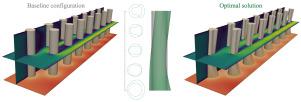3D optimization of heat sink fins using adjoint-based optimization with a CAD-based parametrization
IF 5.8
2区 工程技术
Q1 ENGINEERING, MECHANICAL
International Journal of Heat and Mass Transfer
Pub Date : 2025-09-08
DOI:10.1016/j.ijheatmasstransfer.2025.127722
引用次数: 0
Abstract
This study presents an automated shape optimization method for heat sinks. The computational framework has been developed by combining a conjugate heat transfer solver with adjoint capabilities, a CAD parametrization tool, and a gradient-based optimizer. The test case considers the design optimization of a water-cooled heat sink with pin fins, with the goal of concurrently enhancing heat transfer and minimizing pressure losses. Results show that the optimized fin geometry leads to an improvement of the average heat transfer coefficient by 24% while the pressure drop is lowered by 19%. The optimal fin array features an unconventional shape with an enlarged cross-section at the hub and the top with respect to mid-span, and a variation of the pin profile in the streamwise direction. The net effect is a reduction in flow blockage, an increase in fin efficiency, and a lower and more uniform temperature distribution in the heat sink base plate.

基于伴随优化和cad参数化的散热器翅片三维优化
提出了一种散热器形状自动优化方法。计算框架是通过结合具有伴随能力的共轭传热求解器、CAD参数化工具和基于梯度的优化器而开发的。该试验案例考虑了带针翅的水冷散热器的优化设计,其目标是同时增强传热并最小化压力损失。结果表明,优化后的翅片结构可使平均换热系数提高24%,压降降低19%。最佳的翅片阵列具有非常规的形状,在轮毂和顶部相对于跨中增加了截面,并且在流方向上改变了针形。净效应是减少流动阻塞,增加翅片效率,并在散热器底板更低和更均匀的温度分布。
本文章由计算机程序翻译,如有差异,请以英文原文为准。
求助全文
约1分钟内获得全文
求助全文
来源期刊
CiteScore
10.30
自引率
13.50%
发文量
1319
审稿时长
41 days
期刊介绍:
International Journal of Heat and Mass Transfer is the vehicle for the exchange of basic ideas in heat and mass transfer between research workers and engineers throughout the world. It focuses on both analytical and experimental research, with an emphasis on contributions which increase the basic understanding of transfer processes and their application to engineering problems.
Topics include:
-New methods of measuring and/or correlating transport-property data
-Energy engineering
-Environmental applications of heat and/or mass transfer

 求助内容:
求助内容: 应助结果提醒方式:
应助结果提醒方式:


